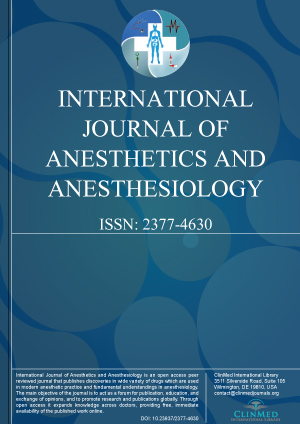Open Access DOI:10.23937/2377-4630/2/1/1024
The Concentration for Loss of Consciousness by Propofol does not differ between Morning and Afternoon
Kumiko Tanabe, Shigemi Matsumoto, Mayumi Nakanishi and Hiroki Iida
Article Type: Short Communication | First Published: March 20, 2015
Background: Circadian rhythms influence the pharmacology and effects of anesthetic agents such as local anesthetics, general anesthetics, and muscle relaxants. However, the influences of the circadian rhythm on new anesthetics such as propofol are unknown. Results: Thirty-seven patients underwent induced anesthesia at 8:30. Twenty-eight patients were induced between 14:00 and 16:00.There was no significant difference between the two groups in the predicted blood concentration, the predicted effe...
Open Access DOI:10.23937/2377-4630/2/1/1022
Management of Anesthesia in A Patient with Myasthenia Gravis
Semih Baskan, Dilsen Ornek, Adem Guney, Fahri Acar, Ozlem Sacan and Mustafa Baydar
Article Type: Case Report | First Published: March 09, 2015
Purpose: This report describes the management of anesthesia in a patient with myasthenia gravis, undergoing thymectomy. Clinical features: The patient was a 22-yr-old female. Thoracic computed tomography revealed a thymoma and a right-side paratracheal lymph node 46x44mm in size. A thymectomy operation was required....
Open Access DOI:10.23937/2377-4630/2/1/1021
Airway Management following Facial Trauma Caused by a Pit Bull Attack
Jaime Ortiz and Kelly A. Frew
Article Type: Case Report | First Published: February 28, 2015
Airway management of patients following facial trauma poses many challenges to the acute care team. An 80 year old male presented following a pit bull attack with massive trauma to his face, scalp and extremities. After carefully considering the options available, we were able to safely secure his airway by utilizing a WuScope. We confirm that the WuScope is a useful tool for airway management in a case of severe facial trauma....
Open Access DOI:10.23937/2377-4630/2/1/1020
Fontan Physiology: Anaesthetic Implications for Non-Cardiac Surgery: A Case Report
Harikrishnan Kothandan, Lim Michelle Leanne and Shital Kumar Sharad Shah
Article Type: Case Report | First Published: February 06, 2015
Patients with congenital heart diseases are a growing population and noncardiac surgeries will become an important health care issue. Modification of surgical techniques and medical advances has improved the survival of patients with complex congenital cardiac abnormalities, resulting in more adult patients with fontan physiology presenting for non-cardiac surgery. The older fontan patient is at particular risk of thromboembolism, arrhythmias, progressive ventricular dysfunction, protein losing ...
Open Access DOI:10.23937/2377-4630/2/1/1019
Proposing a Novel Concept to Evaluate Safety of Supraglottic Devices Regarding Seal Pressure during Laparoscopic Surgery
Jose M. Belena, Monica Nunez and Alfonso Vidal
Article Type: Opinion | First Published: January 23, 2015
It is a fact that Supraglottic Airway Devices (SAD) are currently present at many clinical scenarios in anesthesia and they are also a good alternative to endotracheal intubation in some routine anesthetic procedures. Nowadays, laparoscopy is one of the most common and widely established surgical techniques. This procedures increase airway pressure due to the peritoneal insufflation and consequently the risk of regurgitation and aspiration. Over the last two decades, many studies have establishe...

